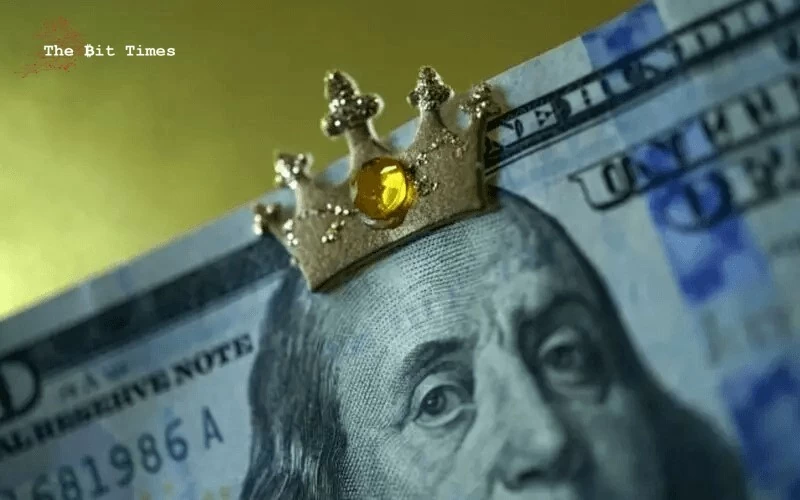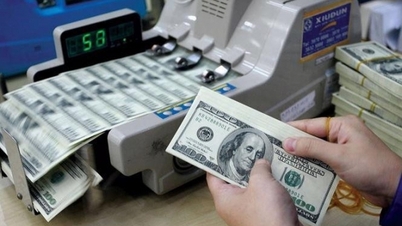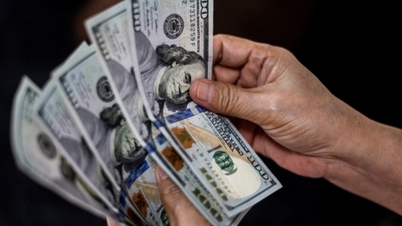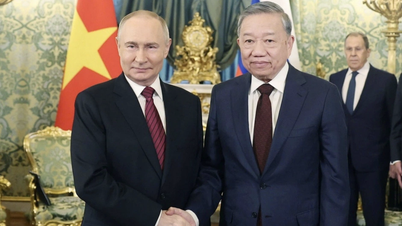The Chinese Yuan, the Indian Rupee and even Asia's top currency, the Japanese Yen, are struggling to counter the dominance of the US Dollar.
 |
| The US dollar counterattacks, BRICS currencies are continuously 'hit by bullets', revealing fatal weaknesses. (Source: AFP) |
Which side is left behind?
Market developments are showing that the USD is not "gentle" with BRICS and the de-dollarization program, causing the leading currencies of the group of emerging economies to slide down the rankings by July 2024.
This reality seems to reflect that the massive de-dollarization campaign of BRICS has not been able to make any difference to the USD, although it has been a bit "difficult".
Meanwhile, the US greenback remains the currency that is putting strong pressure on the currencies of BRICS countries in the foreign exchange market.
On July 26, as the closing bell rang over the weekend, the Indian Rupee, a leading BRICS member, fell to a new record low of 83.73 against the US dollar.
China, the leader in the de-dollarization campaign among BRICS, is seeing the yuan fall to a seven-month low against the US currency.
The Japanese yen has fallen to a 34-year low and is struggling to gain strength in the foreign exchange market.
All current developments show that the USD is still firmly in the lead and leaving other currencies behind.
Rising US Treasury yields have helped the US dollar reverse its trend against major international currencies. The DXY index, which tracks the performance of the US dollar, shows the safe-haven currency above 104.30. And of course, while the US dollar is holding its gains, the same cannot be said for other currencies, including those of the BRICS nations.
The rising US dollar is pushing down BRICS currencies, despite ongoing efforts to challenge the currency's position as the global leader.
In addition, the phenomenon of currency investors taking advantage of the price drop to buy USD strongly, contributing to strengthening the resistance level of this currency, causing it to bounce back more strongly.
“Markets have gotten a little carried away and rising yields have helped the dollar,” said Shaun Osborne, chief foreign exchange strategist at Scotiabank. Now, with Joe Biden’s presidency coming to an end, the greenback’s outlook will be determined by who takes over.
BRICS's failed effort?
However, there are still many different views on the de-dollarization trend of the leading BRICS countries. Among them, the efforts of the members of the group of emerging economies have also left a strong mark. US Treasury Secretary Janet Yellen herself admitted that US sanctions have prompted BRICS to launch strong global de-dollarization initiatives, even "making the RMB the main trading currency instead of the USD".
Specifically, since the US stepped up sanctions against Russia in February 2022, after Moscow launched a special military operation in Ukraine, BRICS has used every measure to cut ties with the US dollar and promote the use of group currencies, such as the Chinese yuan or the Russian ruble, for payments in bilateral trade.
In fact, China's Cross-Border Interbank Payment System (CIPS) also added 62 members in the 12 months to May 2024, an increase of 78% and bringing the total to 142 direct members and 1,394 indirect members.
If the US turns economic sanctions into a weapon, the BRICS members have developed their national currencies into another weapon, by convincing countries that if they continue to use the US dollar as the main means of trade, their economies can always face problems if the US imposes sanctions.
That is why developing countries and BRICS members have decided to move away from the US dollar and start using the yuan when trading with China. In particular, Russia has fully accepted the yuan in oil payments, making the Chinese currency the most used currency for transactions in the past two years.
Leading BRICS members China and Russia are making strides in making the yuan a global currency by reducing the role of the US dollar in international payments. In May 2024, the yuan’s share of foreign exchange transactions hit a new record of 53.6%. Its share in the over-the-counter market was 39.2%.
The Chinese yuan is benefiting from sanctions against Russia, and sanctions have been overshadowed by the BRICS members’ idea of de-dollarization, making the agenda a more powerful force to reckon with, says economic analyst Alexandra Prokopenko.
Fad?
Analyzing the recent strong de-dollarization campaign of BRICS, commodity analyst Jeffrey Christian, also the founder of CPM Group, recently said that the de-dollarization move in leading countries in the bloc such as Russia, China and India could be counterproductive and harm their economies.
The expert emphasized the popularity of the USD in the financial market, so despite the ongoing de-dollarization efforts, the dominance of the greenback will probably not disappear.
In terms of the "balance of power", according to the Bank for International Settlements (BIS), as of April 2022, the US dollar was still used in 88% of all daily currency transactions. Meanwhile, data from the International Monetary Fund (IMF) shows that the US dollar accounted for 54% of total foreign exchange reserves. Meanwhile, other currencies, most notably the Chinese yuan, are still bound by strict capital controls, making them less liquid and therefore less attractive than the US dollar.
Mr. Christian is among the Wall Street skeptics of de-dollarization who see the trend as little more than a buzzword. He calls de-dollarization a “myth,” a fad, and “nonsense.” He is almost certain that the risk of the dollar being replaced by another currency is not a cause for concern.
“De-dollarization is a great idea, but it is very difficult to implement. Because all governments and countries will have to change the way they handle currencies.” The analyst even pointed out the economic consequences for countries that “resolutely” do not use the USD. For example, countries that try to phase out the USD may be holding back their own import and export activities, because the USD is the most widely traded currency in the world, not using this currency can limit the range of trading partners of a country and affect economic growth.
In short, the greenback’s position remains quite stable even as the BRICS group of emerging economies attempts to de-dollarize and shift to other reserve currencies. According to a recent report by the Geoeconomic Center of the Atlantic Council, a research organization on international affairs in the US-Atlantic region, the US dollar continues to dominate foreign exchange reserves, trade payments and currency transactions globally. The role of the greenback as the main global reserve currency is still guaranteed in the short and medium term.
Discussions on an intra-BRICS payments system are still in their early stages, but bilateral and multilateral agreements within the group could form the basis for a currency exchange platform over time, analysts say. However, the scope of these agreements is not easily expanded because they are negotiated individually.
“Western sanctions against Russia have pushed the BRICS countries to develop a currency union, but the bloc has made little progress in its efforts to de-dollarize,” the Atlantic Council report concluded.
Source: https://baoquocte.vn/dong-usd-phan-cong-thang-tay-tien-cua-brics-lien-tiep-dinh-dan-lo-nhung-diem-yeu-chi-tu-280909.html


![[Photo] President Luong Cuong attends the inauguration of the international container port in Hai Phong](https://vphoto.vietnam.vn/thumb/1200x675/vietnam/resource/IMAGE/2025/5/13/9544c01a03e241fdadb6f9708e1c0b65)
![[Photo] President Luong Cuong awarded the title "Heroic City" to Hai Phong city](https://vphoto.vietnam.vn/thumb/1200x675/vietnam/resource/IMAGE/2025/5/13/d1921aa358994c0f97435a490b3d5065)
![[Photo] Many people in Hanoi welcome Buddha's relics to Quan Su Pagoda](https://vphoto.vietnam.vn/thumb/1200x675/vietnam/resource/IMAGE/2025/5/13/3e93a7303e1d4d98b6a65e64be57e870)


![[Photo] Prime Minister Pham Minh Chinh receives Ambassador of the French Republic to Vietnam Olivier Brochet](https://vphoto.vietnam.vn/thumb/1200x675/vietnam/resource/IMAGE/2025/5/13/f5441496fa4a456abf47c8c747d2fe92)





























































































Comment (0)